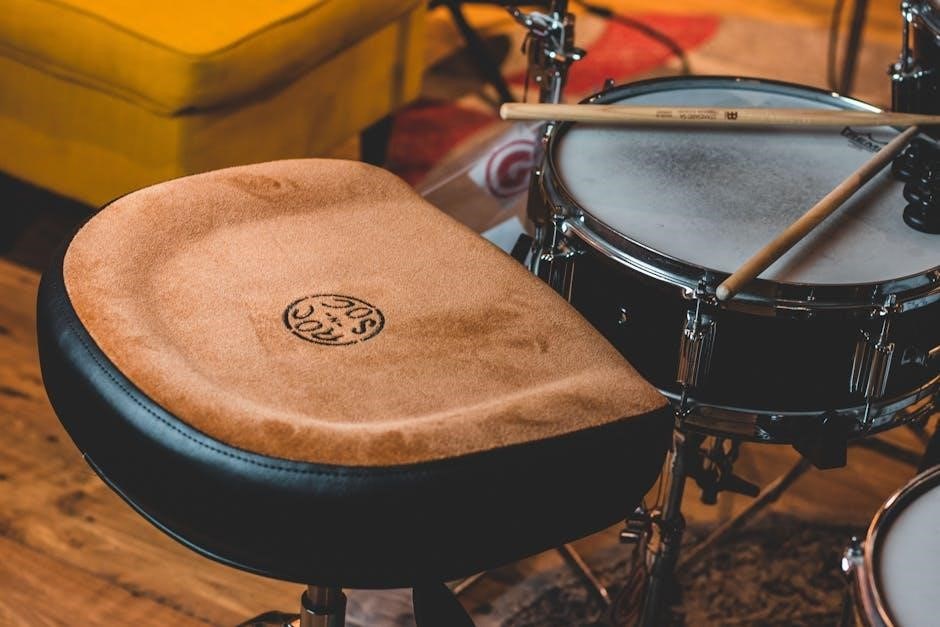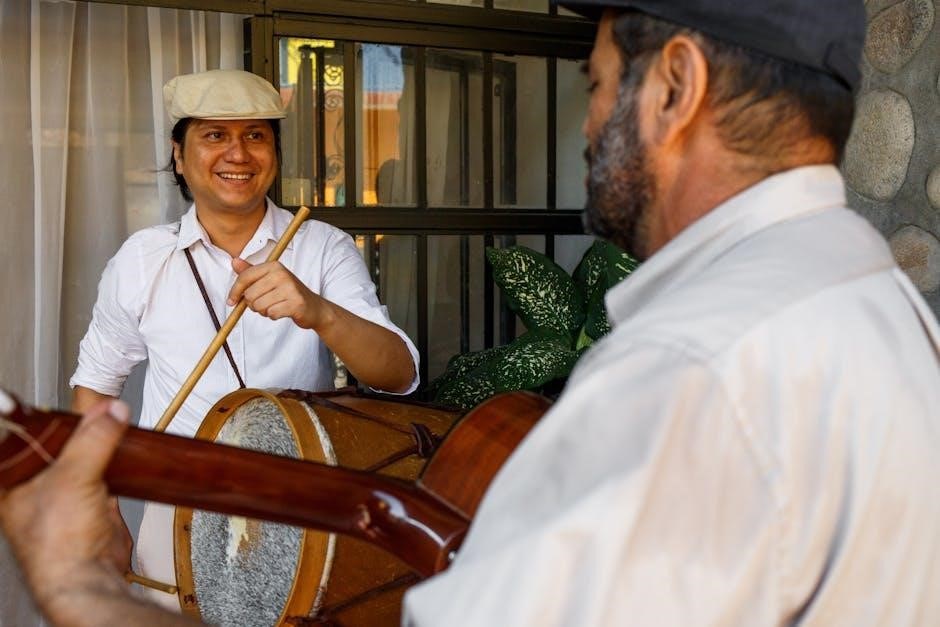Drum rhythms are fundamental to music‚ offering structure and emotion. PDF guides like Colin Bailey’s and Frank Malabe’s provide lessons‚ while chimpanzee drumming highlights rhythmic diversity‚ enhancing skills.
1.1 Overview of Drum Rhythms
Drum rhythms are the backbone of musical expression‚ providing structure and emotional depth. They vary across genres‚ from rock to Afro-Cuban styles‚ and are documented in PDF guides like Colin Bailey’s Bass Drum Control and Frank Malabe’s Afro-Cuban Rhythms. These resources offer detailed patterns and exercises. Additionally‚ rhythmic diversity extends beyond humans‚ as studies reveal chimpanzees exhibit distinct drumming styles‚ with western subspecies using faster‚ evenly spaced beats. Such natural rhythms inspire drummers‚ showcasing the universal language of percussion.
1.2 Importance of Drum Rhythms in Music
Drum rhythms are the heartbeat of music‚ providing structure‚ groove‚ and emotional depth. They define genres‚ from rock to jazz‚ and guide musicians and audiences alike. PDF resources like Gary Chaffee’s Rhythm and Meter Patterns emphasize their educational value. Drum patterns evoke feelings‚ set tempos‚ and unify performances. Their versatility allows adaptation across styles‚ making them indispensable in composition and improvisation. Whether in recordings or live shows‚ drum rhythms are the foundation‚ ensuring music’s dynamic and engaging nature.

Understanding Drum Rhythms
Understanding drum rhythms involves exploring educational PDFs‚ complex patterns‚ and diverse styles‚ from Gary Chaffee’s lessons to chimpanzee drumming‚ enhancing musical appreciation and skill development.
2.1 Basic Components of Drum Rhythms
Drum rhythms are built from fundamental elements like time signatures‚ note values‚ and rests. These components define the structure and feel of a rhythm. PDF guides‚ such as Gary Chaffee’s Rhythm and Meter Patterns‚ offer exercises to master these basics. Dynamics and tempo also play crucial roles‚ shaping the emotional expression of drumming. Understanding rudiments‚ including rolls and flams‚ is essential for executing complex patterns. These elements form the foundation for all drumming styles‚ from simple grooves to intricate polyrhythms.
2.2 Time Signatures and Note Values
Time signatures and note values are crucial in drum rhythms‚ defining the rhythmic structure. Common signatures like 4/4 or 3/4 dictate how notes are grouped. Note values—whole‚ half‚ quarter‚ eighth‚ and sixteenth notes—indicate duration. Rests and accents further refine rhythm. PDF guides‚ such as Gary Chaffee’s Rhythm and Meter Patterns‚ provide exercises to master these concepts. Understanding these elements helps drummers play accurately and expressively‚ ensuring clarity and precision in their performance across various musical genres.
2.3 Common Drumming Patterns
Common drumming patterns form the backbone of various genres‚ from rock to jazz. Basic grooves like the 4/4 rock beat and the swing pattern are widely used. Funk often employs syncopated rhythms‚ while jazz relies on complex timekeeping. Linear drumming‚ as in Stevie Wonder’s “Superstition‚” blends bass and snare for a tight sound. PDF resources like Gary Chaffee’s Rhythm and Meter Patterns offer exercises to master these styles‚ helping drummers adapt to diverse musical settings with precision and creativity.
Types of Drum Rhythms
Drum rhythms vary widely‚ from rock and pop to jazz‚ funk‚ and Latin patterns. PDF guides like Frank Malabe’s Afro-Cuban rhythms offer insights into diverse styles‚ enhancing musicality.
3.1 Rock and Pop Drum Patterns
Rock and pop drum patterns are cornerstone elements in modern music‚ emphasizing strong backbeats and straightforward grooves. These rhythms often use common time and 4/4 structures‚ creating a driving feel. Basic rock beats‚ such as the “Standard Sixteenth Note Groove‚” are versatile and widely used across subgenres. Learning these patterns is essential for drummers‚ with resources like PDF guides and video lessons offering structured exercises. For example‚ the “Linear Drum Beat” in Stevie Wonder’s Superstition showcases a popular technique. These rhythms are foundational‚ making them a great starting point for musicians.
3.2 Jazz and Funk Drum Rhythms
Jazz and funk drum rhythms emphasize syncopation‚ complex time signatures‚ and dynamic expression. Funk drumming relies on strong backbeats and rhythmic accents‚ while jazz often incorporates intricate polyrhythms. Resources like Gary Chaffee’s Rhythm and Meter Patterns and Frank Malabe’s Afro-Cuban Rhythms provide exercises for mastering these styles. Learning these patterns enhances timing and groove‚ essential for both genres. PDF guides and video lessons offer structured approaches to improving technique‚ making these rhythms accessible to drummers of all levels.
3.3 Latin and Afro-Cuban Drum Patterns
Latin and Afro-Cuban drum patterns are vibrant and rhythmic‚ often featuring complex polyrhythms. Styles like the Son Montuno and Bossa Nova emphasize specific rhythmic phrases. Resources such as Frank Malabe’s Afro-Cuban Rhythms and Gary Chaffee’s Rhythm and Meter Patterns offer detailed exercises. These patterns frequently incorporate instruments like congas‚ bongos‚ and timbales‚ blending African and Latin influences. Learning these rhythms enhances musicality and versatility‚ making them indispensable for drummers exploring diverse genres. PDF guides and video lessons provide clear instruction for mastering these intricate beats.

Learning Drum Rhythms
Mastering drum rhythms begins with essential resources like Frank Malabe’s Afro-Cuban Rhythms and Colin Bailey’s Bass Drum Control. These PDF guides offer structured lessons for all skill levels.
4.1 Beginner-Friendly Drum Rhythms
Beginners can start with essential resources like Gary Chaffee’s Rhythm and Meter Patterns‚ offering clear lessons for foundational skills. Free video lessons and drum sheet music provide step-by-step guidance for basic funky rhythms. Practice materials‚ such as PDF guides‚ include simple patterns based on 8th notes‚ ideal for mastering rudiments. These resources help build confidence and technique‚ allowing newcomers to progress smoothly. Start with basic grooves and gradually explore more complex beats‚ ensuring a solid rhythmic foundation.
4.2 Intermediate and Advanced Patterns
Intermediate drummers can explore complex time signatures and polyrhythms‚ while advanced players master limb independence. Resources like Progressive Rock Drumming offer detailed guides for intricate beats. Books with over 260 patterns provide challenges‚ from fills to complex grooves. Advanced techniques‚ such as layering rhythms and dynamic expression‚ enhance musicality. These patterns‚ found in PDF guides‚ help refine skills‚ preparing drummers for professional performance and improvisation in various genres‚ including progressive rock and world music.
4.3 Practicing with PDF Resources
PDF resources offer comprehensive guides for drummers to refine their skills. Books like Colin Bailey ⎼ Bass Drum Control and Frank Malabe ⎼ Afro-Cuban Rhythms provide detailed exercises. These materials cover various genres‚ from funk to progressive rock‚ and include rhythmic patterns‚ fills‚ and limb independence drills. PDFs like Gary Chaffee ⎼ Rhythm and Meter Patterns cater to both beginners and advanced players‚ offering structured lessons. Additionally‚ resources with chimpanzee drumming patterns add cultural insights‚ enhancing rhythmic diversity and inspiration for practice.
Drum Rhythms in Different Genres
Drum rhythms vary across genres‚ from rock and pop’s straightforward beats to jazz and funk’s complex syncopations. Latin and Afro-Cuban styles emphasize percussive richness‚ while progressive rock explores intricate time signatures. Each genre’s rhythmic patterns are uniquely tailored to evoke specific emotions and energies‚ as detailed in various PDF guides and resources.
5.1 Funk and Soul Drumming
Funk and soul drumming emphasize strong syncopation and backbeats‚ creating infectious grooves. Drummers like Stevie Wonder and James Gadson exemplify this style‚ blending rhythm with feel. The “linear drum beat” in songs like Superstition showcases this technique. PDF resources‚ such as Progressive Rock Drumming and Funk and Soul Drum Lessons‚ provide detailed patterns and exercises. These genres rely on tight rhythmic pockets and precise timing‚ making them foundational for modern drumming. Learning these patterns enhances versatility and groove-based playing‚ as highlighted in various drumming guides.

5.2 Progressive Rock Drumming
Progressive rock drumming is renowned for its complexity and technicality. Drummers like Mike Portnoy and Neil Peart have set benchmarks with intricate patterns‚ polymeter‚ and odd time signatures. This genre often incorporates jazz and classical influences‚ requiring advanced limb independence and precision. PDF resources like Progressive Rock Drumming offer detailed exercises and historical context. These guides help drummers master challenging rhythms and understand the genre’s evolution. Such materials are invaluable for those aiming to explore and excel in progressive rock drumming’s sophisticated musical landscapes.
5.3 World Music Drum Rhythms
World music drum rhythms are diverse and rich‚ reflecting global cultural traditions. From Latin and Afro-Cuban patterns to African and Asian beats‚ these rhythms often feature complex polyrhythms. Resources like Frank Malabe’s Afro-Cuban Rhythms for Drummers provide in-depth lessons. Outdoor performances highlight drumming’s role in attracting audiences‚ blending percussion with vibrant energy. These rhythms not only enhance musicality but also preserve cultural heritage‚ offering drummers a gateway to explore and master global rhythmic traditions through detailed PDF guides and practical exercises.
Resources for Drum Rhythms
Drum rhythms PDFs offer extensive resources‚ from Colin Bailey’s Bass Drum Control to Frank Malabe’s Afro-Cuban guides‚ providing lessons‚ exercises‚ and sheet music for all skill levels.
6.1 Free PDF Guides and Worksheets
Free PDF guides and worksheets are invaluable resources for drummers. Colin Bailey’s Bass Drum Control and Frank Malabe’s Afro-Cuban rhythms offer extensive lessons. Additionally‚ PDFs like Gary Chaffee’s Rhythm and Meter Patterns provide structured exercises. These resources cover various styles‚ from basic grooves to complex polyrhythms‚ catering to all skill levels. Many guides include sheet music and video lessons‚ making them accessible for self-study. They are essential tools for improving technique‚ exploring genres‚ and mastering drumming fundamentals effectively.
6.2 Online Tutorials and Videos

Online tutorials and videos are excellent for visual learners. Platforms like YouTube and Drumeo offer lessons on rhythms‚ from basic grooves to advanced patterns. Video tutorials provide step-by-step guidance‚ making complex techniques accessible. For example‚ lessons on Stevie Wonder’s “Superstition” groove teach linear drumming. Many tutorials include PDF sheet music‚ combining visual and written learning. These resources are ideal for self-study‚ allowing drummers to practice at their own pace and refine their skills effectively. They cater to all levels‚ offering a diverse range of styles and genres.
6.3 Books and Sheet Music
Books and sheet music are invaluable resources for drummers. Titles like Colin Bailey’s Bass Drum Control and Frank Malabe’s Afro-Cuban Rhythms offer in-depth lessons. Gary Chaffee’s Rhythm and Meter Patterns provides exercises for improving timing and technique. Many drum books‚ such as those focused on progressive rock‚ include sheet music and patterns for popular songs. These materials often cover various styles‚ from funk to world music‚ and include rudiments and advanced techniques. They are essential for structured learning and mastering diverse rhythmic styles‚ catering to both beginners and advanced players.

Advanced Drumming Techniques
Advanced drumming techniques involve polyrhythms‚ complex time signatures‚ and limb independence. These skills enhance musical depth and expression‚ allowing drummers to explore intricate rhythmic patterns and dynamics.
7.1 Polyrhythms and Complex Time

Polyrhythms and complex time challenge drummers to play multiple rhythms simultaneously. For example‚ a 3-over-2 pattern layers three notes over two‚ creating intricate grooves. Time signatures like 17/8 or 19/8 demand precise timing. PDF guides‚ such as Gary Chaffee’s Rhythm and Meter Patterns‚ offer exercises to master these concepts. These techniques are essential for progressive rock and jazz fusion‚ where unconventional time signatures are common. Practicing with metronomes and breaking down patterns helps build proficiency in these advanced rhythmic structures.
7.2 Dynamics and Expression
Dynamics and expression add depth to drumming‚ allowing drummers to convey emotion through varying intensities. From subtle ghost notes to powerful accents‚ these elements enhance musicality. PDF resources like Gary Chaffee’s Rhythm and Meter Patterns provide exercises to refine control. Expression is also evident in chimpanzee drumming‚ where rhythmic patterns vary in intensity‚ showcasing natural dynamics. Mastering these techniques elevates a drummer’s ability to connect with audiences and interpret music authentically‚ making dynamics a vital component of advanced drumming skills.
7.3 Limb Independence Exercises
Limb independence exercises are crucial for drummers to master complex rhythms. These exercises involve coordinating arms and legs to play different patterns simultaneously. PDF guides‚ such as Gary Chaffee’s Rhythm and Meter Patterns‚ offer detailed workouts. Start with single-limb strokes‚ then progress to combining limbs. For example‚ play single strokes with one hand while maintaining a double stroke with the other. Regular practice enhances coordination and rhythm precision‚ preparing drummers for advanced patterns and polyrhythms in various musical genres.

Cultural Significance of Drum Rhythms
Drum rhythms hold deep cultural significance‚ used in rituals‚ ceremonies‚ and traditional music. They preserve heritage and foster community‚ with unique patterns expressing identity and unity across generations.

8.1 Traditional Drumming Styles
Traditional drumming styles vary across cultures‚ often tied to rituals and ceremonies. For example‚ Afro-Cuban rhythms emphasize polyrhythms with instruments like congas and bongos. PDF guides like Frank Malabe’s Afro-Cuban Rhythms for Drummers provide detailed lessons. These styles‚ passed down through generations‚ reflect cultural identity and community bonding. Additionally‚ chimpanzee drumming patterns highlight rhythmic expressions in nature‚ showcasing the universal appeal of drumming. Such traditional styles offer a rich foundation for learning and appreciation‚ as seen in resources like Gary Chaffee’s Rhythm and Meter Patterns.
8.2 Drumming in Rituals and Ceremonies
Drumming plays a vital role in rituals and ceremonies worldwide‚ often serving as a connector between communities and the divine. Loud‚ rhythmic patterns with drums and percussion instruments are used to attract listeners and create emotional intensity. These rituals‚ such as Afro-Cuban ceremonies‚ rely on intricate polyrhythms. PDF guides like Frank Malabe’s Afro-Cuban Rhythms for Drummers provide insights into these traditional patterns‚ emphasizing their cultural and spiritual significance. Drumming in such contexts is not just music but a powerful form of communal expression and connection.
8.3 Chimpanzee Drumming Patterns
Research reveals that chimpanzees exhibit distinct drumming patterns‚ with western subspecies using evenly spaced‚ faster beats‚ while eastern subspecies display more complex rhythms. These patterns‚ analyzed in studies published in Current Biology‚ highlight rhythmic diversity among chimpanzee communities. Such findings emphasize the evolutionary roots of rhythm and its universal presence‚ from animal behavior to human music. PDF resources on drum rhythms often reference these studies‚ illustrating the deep connection between nature and musical expression.

Modern Applications of Drum Rhythms
Modern drum rhythms are integrated into electronic music via drum machines and software. Tools like DAWs enable creation of intricate patterns‚ blending acoustic and digital elements for versatile performances.
9.1 Drum Machines and Electronic Music
Drum machines revolutionized music production‚ enabling precise rhythmic patterns in electronic genres. Tools like Roland TR-808 and TR-909 shaped modern beats‚ offering programmable drum rhythms. PDF guides reveal how artists integrate these machines into live performances and studio recordings‚ blending acoustic and digital elements. Software like PureData extends rhythmic possibilities‚ allowing polyphonic drum generation. This fusion of technology and rhythm has redefined music creation‚ making drum machines indispensable in contemporary electronic music production and performance.
9.2 Software for Creating Drum Patterns
Software has become a cornerstone for modern drum pattern creation‚ offering unparalleled flexibility. Tools like PureData enable the generation of polyphonic drum rhythms‚ while others provide libraries of pre-designed patterns. Many programs allow users to customize beats‚ sync with hardware‚ and even import MIDI files. PDF guides and tutorials are often included‚ helping musicians master these tools. This technological advancement has democratized drum pattern creation‚ making it accessible to producers and drummers alike‚ while fostering innovation in rhythm design and musical collaboration.
9.4 Live Performance and Improvisation
Live performance and improvisation bring drum rhythms to life‚ allowing drummers to express spontaneity and creativity. Drummers often adapt basic patterns into dynamic performances‚ incorporating fills and variations. Improvisation enables real-time interaction with other musicians‚ creating unique musical moments. PDF resources and video lessons provide insights into mastering these skills‚ while famous drum beats inspire live interpretations; Whether in rock‚ jazz‚ or world music‚ live drumming showcases rhythm as a living‚ breathing art form‚ connecting audiences with the heartbeat of music.
Drum rhythms are the heartbeat of music‚ offering endless creativity and expression. With PDF guides and resources‚ mastering rhythms is accessible‚ inspiring drummers to explore and grow.
10.1 Summary of Drum Rhythms
Drum rhythms are the backbone of music‚ providing structure and emotional depth. Resources like Colin Bailey’s and Frank Malabe’s PDF guides offer comprehensive lessons‚ while Gary Chaffee’s works explore rhythm and meter. Chimpanzee drumming patterns highlight rhythmic diversity in nature. From rock to jazz‚ these rhythms inspire creativity and technical mastery. Whether through sheet music or video tutorials‚ drum rhythms continue to evolve‚ bridging cultural gaps and fostering musical expression across genres and generations.
10.2 Future of Drumming and Rhythms
The future of drumming and rhythms is evolving rapidly‚ blending tradition with technology. Drum machines and software enable creators to craft intricate patterns easily. Research into chimpanzee drumming reveals new insights into rhythmic diversity. As global music fuses‚ drummers incorporate diverse styles‚ pushing boundaries. With resources like PDF guides and online tools‚ learning and innovation are more accessible. The integration of electronic elements and cultural exchange promises a vibrant‚ dynamic future for drumming and rhythmic expression.
10.3 Encouragement for Aspiring Drummers
Aspiring drummers‚ embrace your passion and dedication. With resources like PDF guides‚ video lessons‚ and exercises‚ learning drum rhythms is more accessible than ever. Start with beginner-friendly patterns and gradually explore complex styles. Practice consistently‚ and don’t hesitate to seek inspiration from legendary drummers. Join online communities and workshops to connect with fellow enthusiasts. Remember‚ drumming is a journey of creativity and growth. Stay motivated‚ enjoy the process‚ and let your rhythm shine!

